I had brought my usual paddle - a Carlisle Day Tripper cheapie - and the fancy one, to see what difference they made. Beginning with the cheapie I pulled the yak into the water and paddled slowly out straight through the surf. Again, it held a very straight track through this and I remained dry. I turned and went back in, again very straight and dry and repeated the exercise with the two-piece. I then repeated the exercise a further time but quicker and once again it handled it fine, riding straight over the waves and keeping me dry – basically unless you have one curl over just as you hit it you should stay pretty dry.
I then tried sitting side saddle, something I personally don’t tend to do, and it was fine. There is plenty of buoyancy so it doesn’t let a noticeable amount of water in but I didn’t feel too secure – the reason I don’t normally sit side saddle – as the kayak will weathercock and move with the swell and the high seating position does enhance the movement. It was fine though.
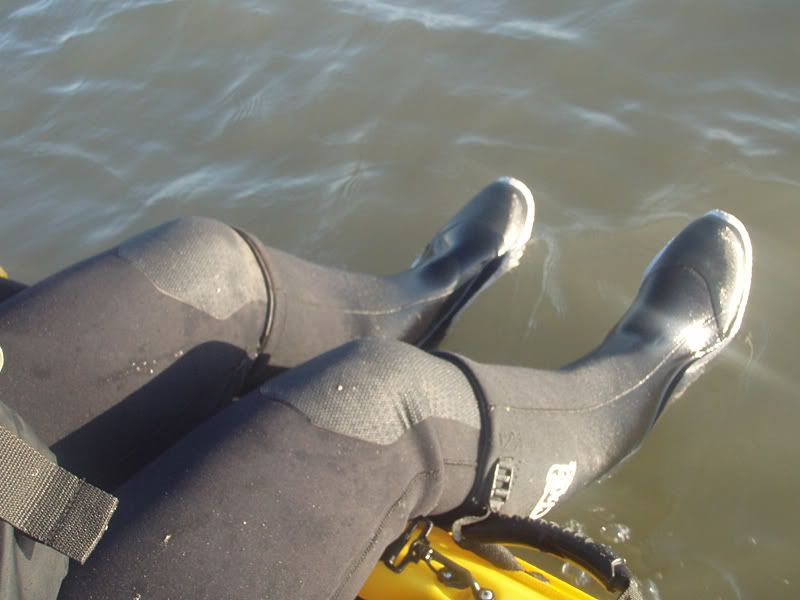
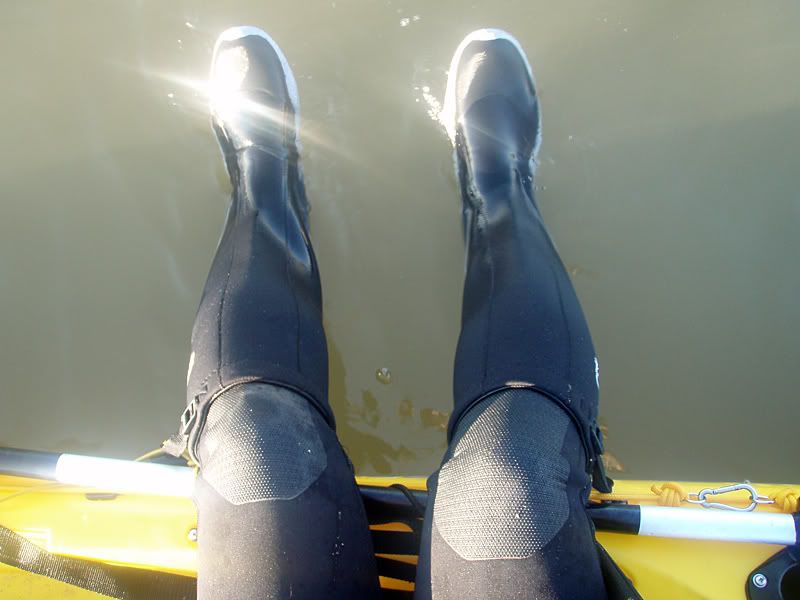
Reaching around to the back of the tankwell was also tried and this was easier than on the Prowler 15. I also went forward and opened and closed the bow hatch, again with no difficulty and the high, buoyant bow kept it clear of any ingress of water. Very stable kayak this.
I paddled over to an area where the surf is usually bigger and more uneven (getting broken up by the pier legs). Swell was 3-4ft but not really producing rideable surf, although the water was very broken. I pointed my nose at a groyne (down boy!) and sat there. And sat there. It stayed straight, just bobbing up and down with the swell. I may as well have been at anchor.
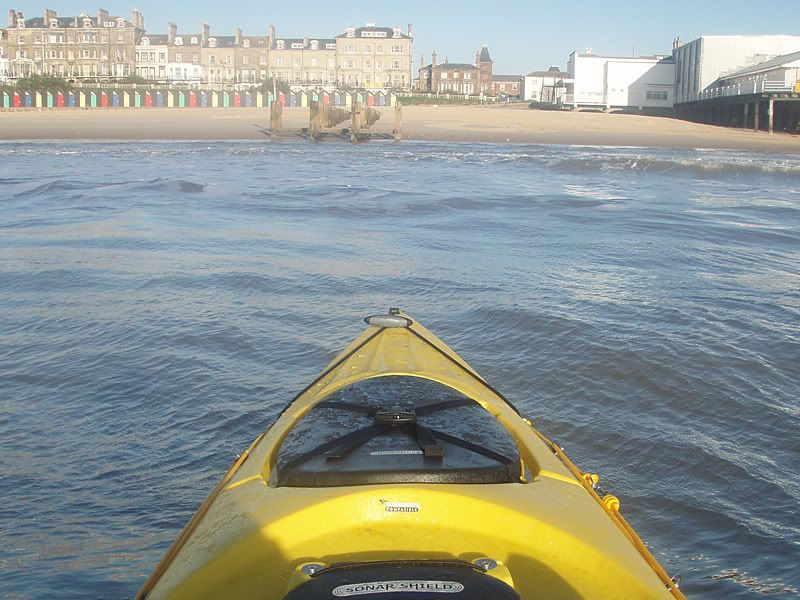
The tide was quite far out now and the water was shallow – between 1 and 3 feet and I sat side on to the surf for a good while, staying pretty dry (it was small surf by this point, maximum 2 feet) and not rolling over or being pushed around in direction. The following photograph was something I wouldn’t try in the P15 but which was fine with the Trident. I was in 12-18 inches of water, side on to the surf and paddled through the legs of the pier. The water is very messy here and runs fast; there are also banks around the pier so it does tend to be unpredictable. Spacing between the legs is I would say about 12 feet – not sure, but thereabouts. I went through easily and without being pushed much off course at all.
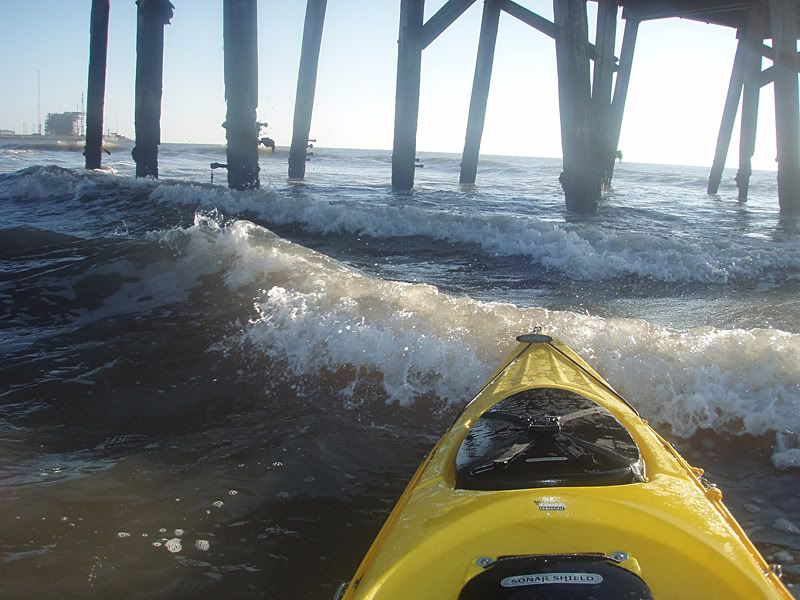
I paddled back to where I had launched and played some more in the surf. Although not designed as a surf boat this naughty little minx just wants to play! Well, play we did for a good half an hour. I couldn’t ride any of the waves today but I paddled into shore forwards, out forwards, in backwards, out backwards, in laying flat pointing forwards, out laying flat pointing forwards, in laying flat pointing backwards and out laying flat pointing backwards, the lying down ones repeated with my legs crossed as if having a kip. Now, there is no sane reason nor justification for most of those exercises, they were pointless and wouldn’t be used normally, but for the sake of doing them they were done. They were all VERY easy, the direction holding and mostly I kept dry, with the exception of some of the backwards ones on the way out, dependant on the breaking of the wave.
At this point Mike (Mb) arrived and so I handed over the Trident and went and fetched a Prowler 15, which I had fitted my Pacific Action sail to. Two reasons – Mike was enquiring about them the other day and the wind was strong. Coming back to the beach ten minutes later he looked dry (and resplendent in his new dry gear) and we went out again after I placed my C-Tug in the bow hatch of the Trident to try things with a bit more weight in. I also placed a paddle in the paddle keeper to make sailing easier and deployed it, trying to sail right off the beach. I couldn’t because of the position of the groyne so instead paddled out a little bit and then started to move quite quickly. Glancing back Mike was standing in the water, a wave having caught on the stowed paddle, knocking it up and hitting him. He stowed it again and launched with ease – but he couldn’t catch me, I was flying. I played around a bit doing a good rate of knots and then came back to where he was. I crossed the wind both times and having had a good successful sail (with virtually no effort on my part – in fact I was on the mobile for a few minutes of it to a mate who was too slow waking up to join us). I think I’ll put one on the Trident too; it certainly does make things a breeze (!)
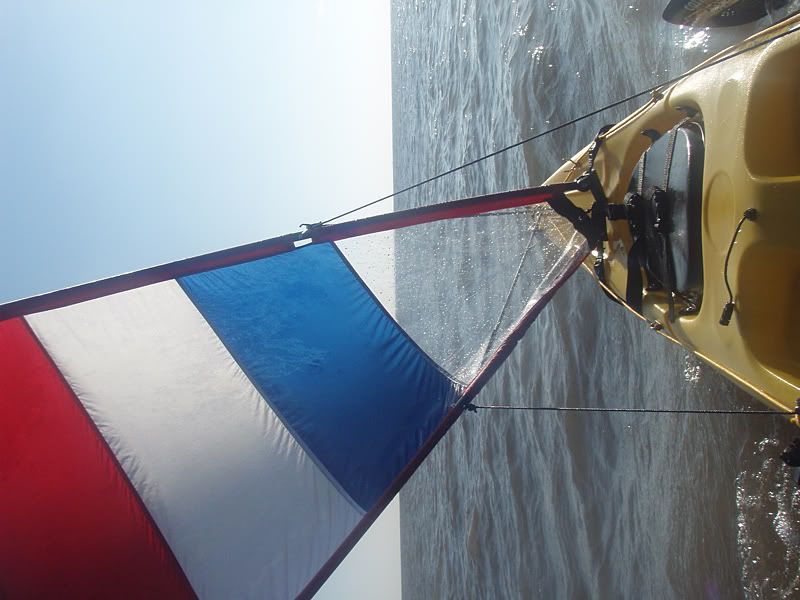
Now Mike and I tested the weather-cocking. I felt the other day that it was slower to turn with the wind than the 15. I was wrong. We got parallel to each other but with a bit of space between us so as to not block the wind. We both pointed at a particular shore mark and called out as we turned to another. We then swapped boats and repeated the exercise as a control check to ensure it wasn’t dependant on the person in the saddle (shape, weight, wind resistance, lack of hair etc). That’s a story in itself and will follow in a moment. The verdict was unanimous – the Trident weathercocks quicker. Substantially quicker. I can’t say accurately but at a rough guesstimate I’d say between 20 and 40% faster than the Prowler 15.
Swapping boats. Apart from the weather cocking we both wanted to do some capsize drills and I especially needed to test the Trident for this. Plus Mike wanted to try the sail. So, instead of doing things on dry land, or getting in the water and then into the other one we decided to cross-deck. Good idea that. I got out of the Prowler and across to the Trident. So for a while we had Mike and I both on it, me forward and him near the seat. It felt stable enough. However, when Mike went across to the Prowler we became unstuck – literally. The Prowler tipped on its side when the weight was put on it and try as he might Mike couldn’t get it to behave. I was my usual helpful self and took a photograph but I don’t think Mike will forgive me for posting it! Still, he tested his dry gear – custom made locally by Liquid Logic – just not when he was expecting to. He soon clambered back in and I retrieved my camera from the Rod Pod and hung it around his neck. This was the first time I’ve seen Mike look worried on the kayaks; I told him to be careful because that was £2k of camera. I then handed him my compact – which is waterproof and asked him to snap me doing the capsize drills with the Trident:
I got in on the leeward side and flipped her over:
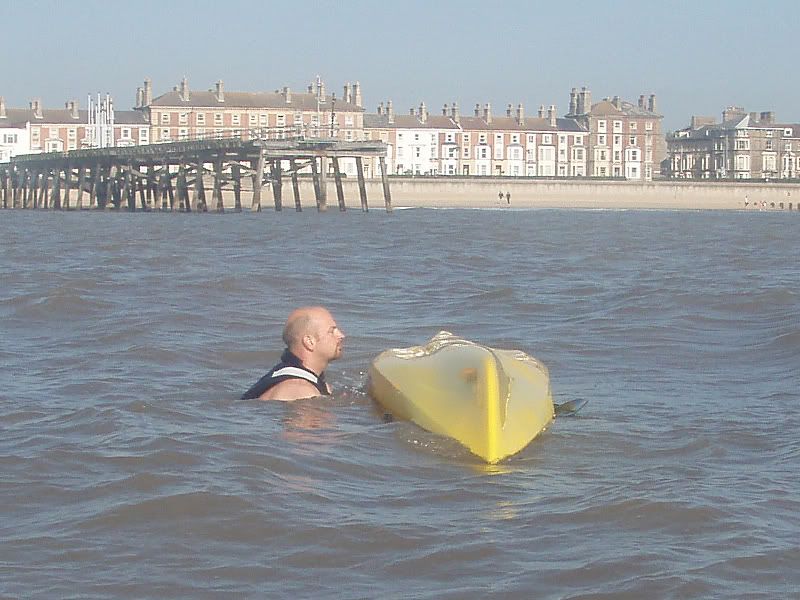
Reaching over, I turned her right way up:
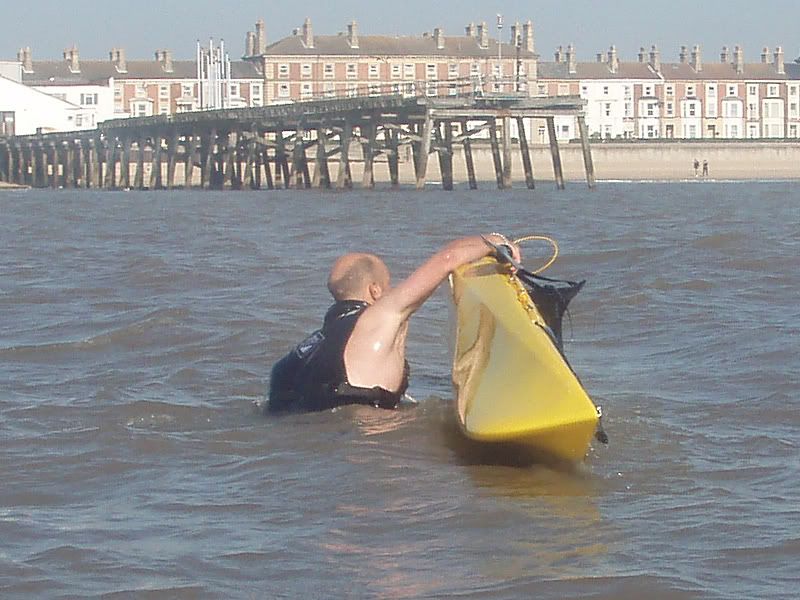
Kicked myself on:
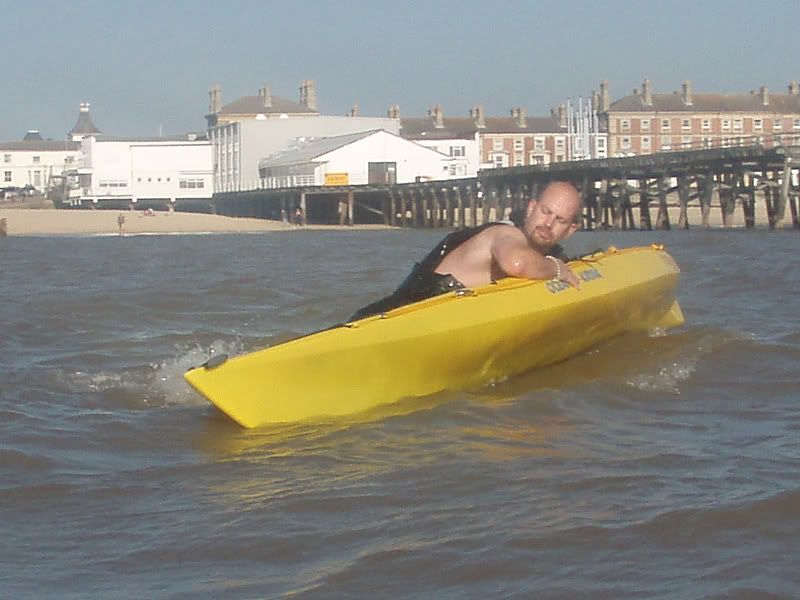
And clambered aboard:
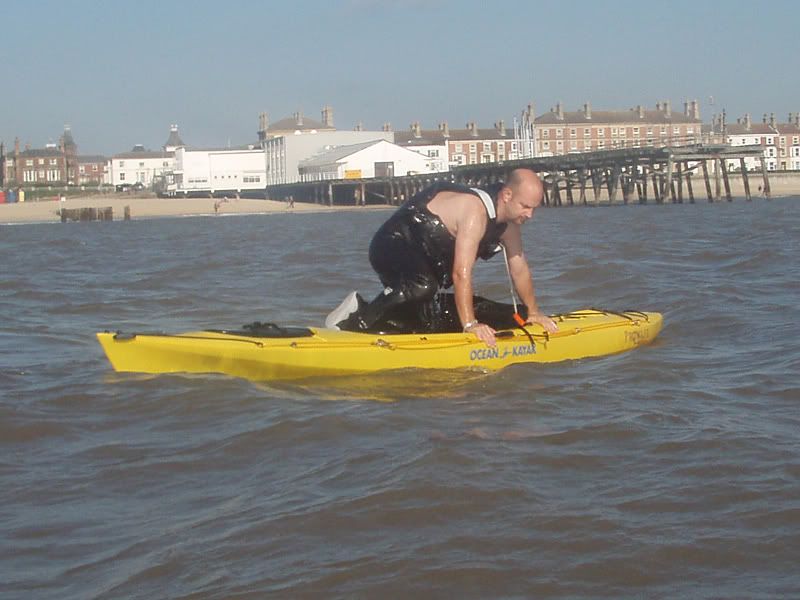
Simple. Now for the windward side.
Flipped her over:
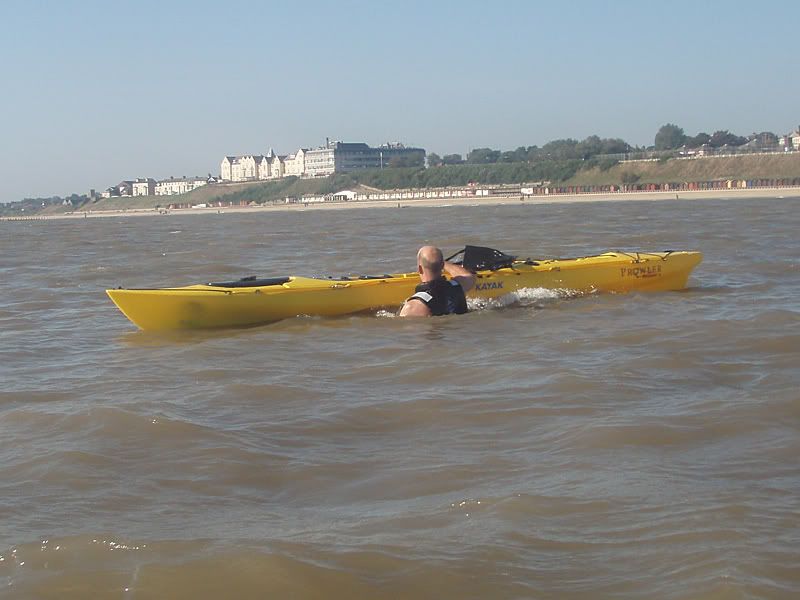
Reached over and began hauling myself up:
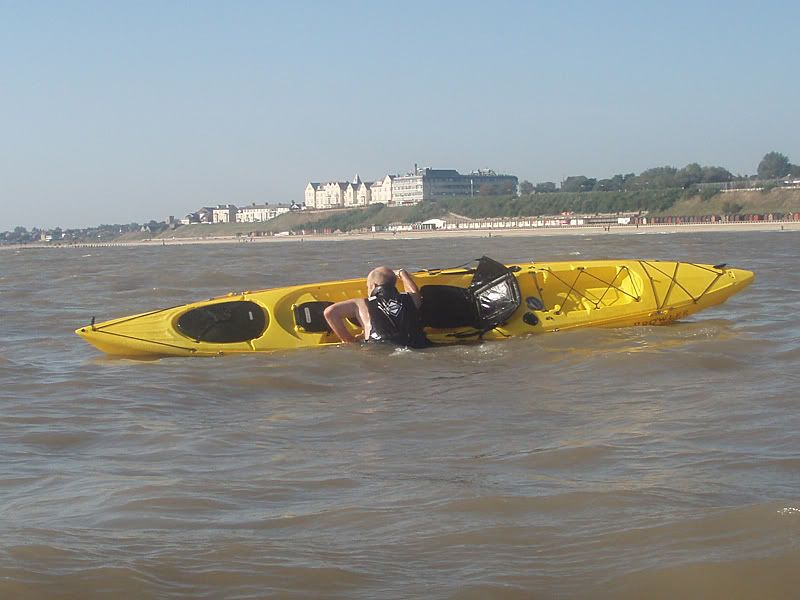
Clambered in:
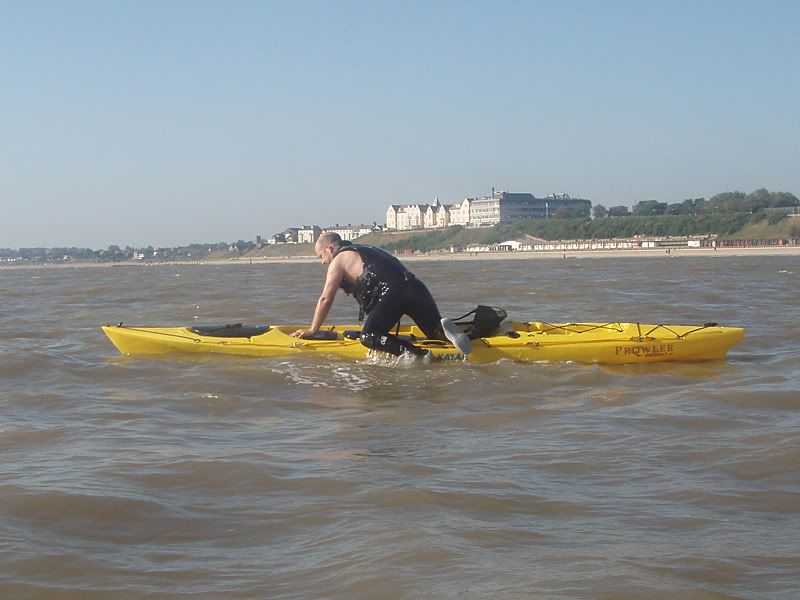
And made myself comfy.
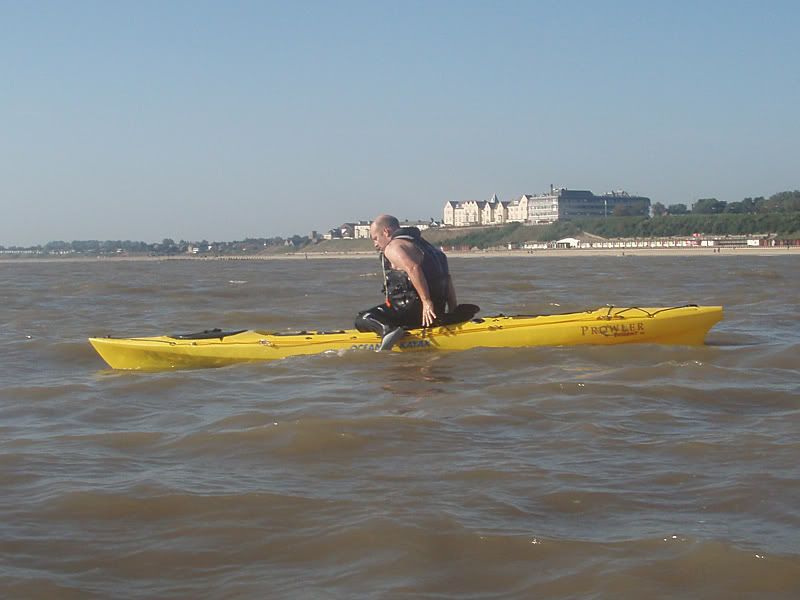
It was like getting into bed. The buoyancy and shape I assume is what makes it so easy to right – it sits high (but not so high you can’t reach over) and can be flipped back over very easily – far easier than the P15. There is also more space to put your feet etc and the buoyant wide gunwhales give you plenty of stability. There was no tippiness, no effort to pull here over, nothing, on either side of the boat. VERY safe in that respect.
Then just for the sake of it, I decided to stand up. The first attempt I was trying to work out how to stand and went in. I got out and tried again:
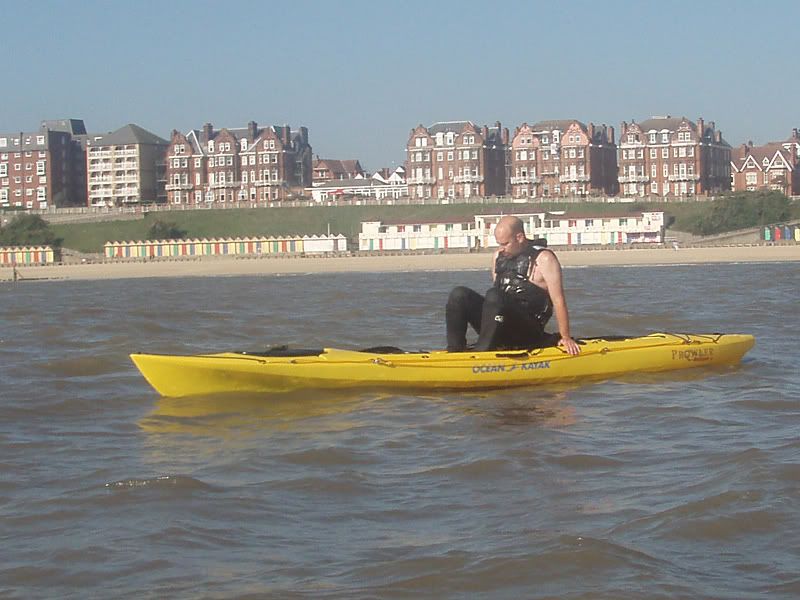
Having worked it out I got up easily enough:
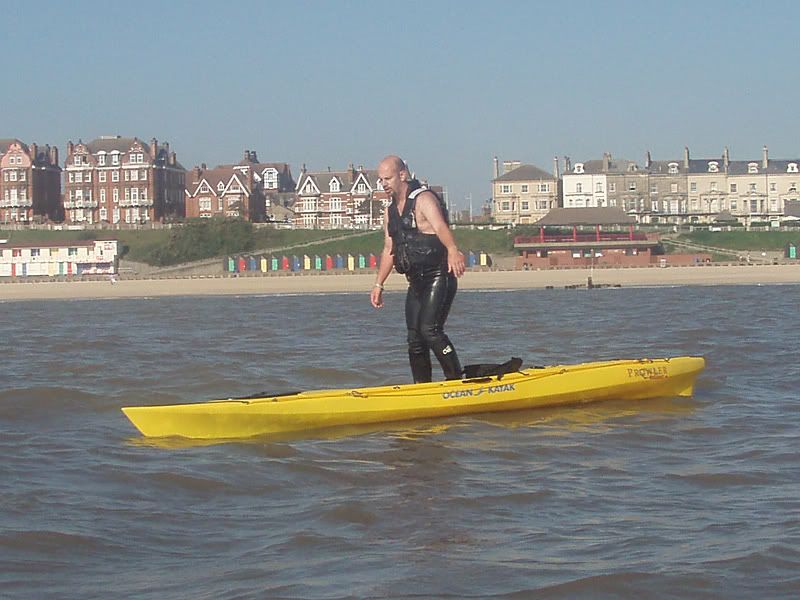
And stayed standing upright for a good 30 seconds I’d guess, the sea wasn’t flat either. More stable than the 15 which I’d have gone over the side in seconds on. I then started to get myself back down and went for a swim. I’ll stay seated when fishing I think.
Mike deployed the sail and got the hang of it as soon as he started. He was off and I was paddling as hard as I could to keep up.
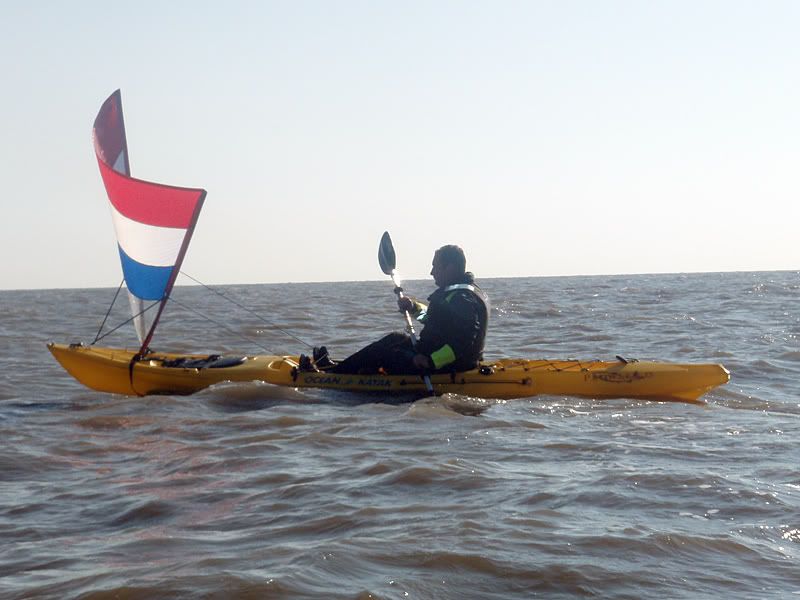
This is the point when I start evaluating the paddling of the Trident, the important part and so I have kept it until last so that I can pull it all together.
First I must say that it was a practically empty boat. I had, in the hull, a camera weighing a couple of pounds, a fleece, a carbon fibre paddle and one (later two) C-Tugs. This kayak is designed as a fishing platform and thus to be carrying weight, so this paddle review is only half of the story, to be continued when I load it up. So please do bear that in mind. Everyone so far who I have spoken to that has paddled it says it is two different beasts dependant on what’s in/on it. Comments are ONLY valid for an empty kayak, strong wind and saltwater. I can’t stress this enough.
To begin, I paddled out trying to keep a straight line. I couldn’t. It veered off to the right (the wind was pretty much right to left), repeating the experience of the other day. This also happened with Mike. I must say that I have never used a rudder on a kayak but if what I understand of them is correct then this kayak definitely needs one.
You can’t use a short paddle effectively as you are up high. It will do the job, but it is more tiring. You can do close-in and reaching-out strokes with ease (I don’t know the technical terms) and can rudder/turn with the blade to the rear with no bother too. But it is a hard boat to paddle in open sea compared to the P15. It seems to wallow quite a lot and takes a lot of effort and a lot of time to get anywhere. That’s across the wind. Against the wind and before the wind it moves a lot more efficiently, being easier to physically move and keeping a better course. Some hull slap was evident at times, but not a lot and it was dependent on wind and wave direction and also speed. It wasn’t enough to be of concern but I did take note of it for the review.
Paddling in the surf is largely described earlier in the text but it paddles far easier than in open sea in these conditions. Surf was, in fact, the only time in which I’d say the Trident paddled better than the Prowler 15 – but it was a hundred times better.
Turning. It seems to turn a lot easier and in a smaller circle than the 15 even though it’s longer by ten centimetres or so. I need to do a proper comparison on a river during a calm day but that is my feeling for now.
It’s slower than the Prowler 15 too, doesn’t cut through the water half as well. The 15 doesn’t have the buoyancy of the Trident of course and is a lot lower and wetter to ride.
So, all in all an interesting couple of hours. I tried as many things as I could, including some that I would never dream of doing in normal situations. In many ways the Trident fell short, and in just as many others it excelled.
No comments:
Post a Comment